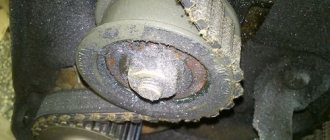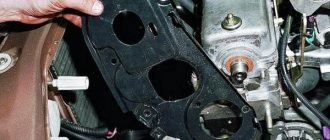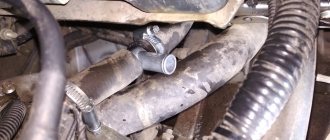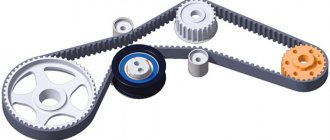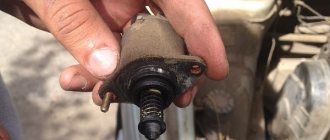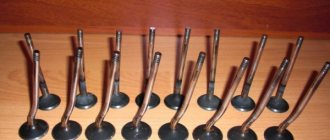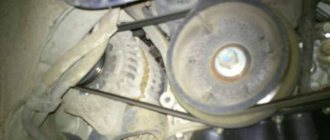Gas distribution system VAZ-2114
It will not be a secret to anyone that over time, any part will wear out and require replacement; for some, this period is measured in hundreds, for others, tens of thousands of kilometers.
Timing mechanism diagram
As for the gas distribution mechanism system, and specifically its belt, replacement should be done at the end of its service life, or if there is visible damage to it.
However, it should be noted that when replacing an old belt with a new one, a problem may occur such as the belt sliding out of its place, which in turn can lead to eating (wear - approx.) of the edge of the belt, which in the future will only contribute to its wear, break and another replacement.
We hasten to please you
The VAZ-2114 car was equipped only with an 8-valve engine, with a volume of 1.5 and 1.6 liters, which may indicate that when the timing belt breaks, the pistons and valves do not meet and the latter do not bend , which is certainly favorable affects not only subsequent repairs, but also the car owner’s wallet.
Troubleshooting methods
Now we list methods for eliminating these causes. Let's go in the same order.
- Belt tension . First you need to check the tension level and compare it with the one recommended by the car manufacturer (usually indicated in the technical documentation for the car, also can be found on the Internet). If this value is higher than the recommended value, then the tension must be loosened. This is done using a torque wrench. If you don’t have one, then it’s better to contact a car service. As a last resort, you can perform this procedure “by eye,” but use the indicated devices as soon as possible. You can also use a regular dynamometer and a regular wrench for this.
- Poor quality belt . If the two edges of the belt have different stiffness, then a situation will arise where the timing roller eats the belt from the softer side. You can check this by replacing its right and left sides. If after replacement the second side does not wear out, then the belt is to blame. There is only one way out, and it consists in purchasing and installing a new, higher quality part.
- Wear of pump bearings . To diagnose this problem, it is necessary to dismantle the belt and check for play on the toothed pulley. If there is play, it means the part needs to be replaced. Bearings cannot be repaired.
- The pump is installed crookedly . This situation is possible if, during the previous replacement, the adjacent surface was poorly cleaned, and small particles of the old gasket and/or pieces of dirt remained on it, but if this happens, then most likely you will understand this by the leak that appears after filling the antifreeze and starting the engine. When installing a new pump (or even an old one, if it is in good condition), be sure to thoroughly clean both surfaces (including the bolt holes), both on the pump itself and on the motor housing, and install a new gasket. In some cases, instead of a gasket, sealant is placed under the pump.
- Problems with the video . The video needs to be reviewed. It should have minimal play and a flat working surface. To check, you can use a ruler or other similar object of the required width. It also makes sense to check the presence of grease in the bearing. If its quantity is small, it should be added. If the roller is of poor quality, it must be replaced. It is almost impossible to repair the bearing, much less the roller surface.
- Damage to stud threads . To correct this situation, there are two options. The simplest is to use a saw with the appropriate diameter for turning internal threads and/or a die for turning similar threads on a stud. Another option is more labor-intensive and involves completely dismantling the block in order to restore the specified thread. This method is used if for some reason it is impossible to use the sword.
Installing washers under the roller
Where does the belt slip and why?
Note! The belt can slip either towards the engine or in the opposite direction from it.
This happens regardless of how exactly it was installed in the middle of the gear, since the reason for this is not only the belt itself, but also the elements and mechanisms accompanying its operation. In order to solve this problem, you need to use the methods described below.
Timing belt
In modern times, in the automotive spare parts market, facts of counterfeits and low-quality products are becoming more and more common.
The top is the original timing belt and the bottom is a fake.
Specifically touching on the issue with the timing belt, we can talk about its uneven structure, increased elasticity (the ability to stretch excessively - approx.), as well as the presence of significant differences between the two edges (distortion - approx.).
The degree of straightness of the newly installed belt can only be determined on the mounted mechanism.
And, if even minor deviations are observed after starting the engine, then the reason is in the belt.
Belt is on and tight
water pump
The timing belt can slip due to play in the pump (pump - approx.). It is very easy to determine its presence; you just need to grab the working surface of the gear with your hand, and if there is even the slightest play, the unit must be changed. In this case, read the material: “choosing a reliable pump for the VAZ-2114”
Leaks on the cylinder block from the timing side indicate that the pump has failed
Tension roller
The next element that needs to be diagnosed when the timing belt is slipping is the tension roller.
Although it may seem like a simple part, deviation from its performance specifications can significantly affect the overall correct operation of the part. In simple terms, a curved roller will not be able to provide the belt with linear movement , wearing out and moving it to the side.
The diagram is clear and understandable.
Another reason for discussions on popular forums about the belt moving to the side is the installation of rollers of different types, because the analogue has a different, slightly modified design.
The difference between the rollers
The difference between these two spare parts is that the old side has a different shape, made of metal, while the new one is made of plastic.
Therefore, as the theory shows, a spare part made of plastic causes much less friction than its metal counterpart.
There are two types of rollers.
Reasons for slipping
ATTENTION! A completely simple way to reduce fuel consumption has been found! Don't believe me? An auto mechanic with 15 years of experience also didn’t believe it until he tried it. And now he saves 35,000 rubles a year on gasoline!
As a rule, the complications of a 1.5-liter eight-valve internal combustion engine after a routine scheduled change of a rubber timing belt product that has “plowed away” its issued life are familiar to many owners. It consists in the fact that the new part now jumps off, which inevitably leads to its breakage. If on such engines, when the rubber ring ruptured, mutual collision of the valve-piston elements was observed, major repairs would have been impossible to avoid.
But on a 16-valve unit, the results of a timing ring rupture are much sadder. In this case, stopping the engine alone will not end.
On the other hand, why does the belt still slide out? And this happens both towards the power plant and vice versa. Well, how long can you change the belt, it’s time to find the cause and eradicate it.
Reason 1: the culprit is the belt
The fact that these days the quality of new parts does not stand up to criticism does not surprise anyone. And it would be correct to say that the main factor in the slippage is precisely the unoriginality and poor quality of the timing belt. It is no secret that a rubber element with an uneven structure, which tends to stretch differently in certain places, is no longer an option. Such a belt will always have a misalignment, albeit imperceptible to the eye, but extremely negatively affecting the operation of the part.
Note. You can check the belt crookedness as follows. It is necessary to turn it over on the drive, and then diagnose operation in this position. If the belt starts to slip in the other direction, the problem is in the belt itself.
The mistake of the manufacturer, who allowed the product to be defective, gives us a belt with different rigidity in width. As a result, the rubber part, under the influence of force, “floats” in the direction of less elasticity. And this happens virtually immediately after installation.
Reason 2: pump
The second common cause is related to play in the coolant pump shaft. Popularly, this problem is called “pump overshoot.” The presence of play is quite easy to determine: you need to remove the belt and check the pump gear for rolling. If there is play, the pump will have to be replaced, since sooner or later it will completely fail, if this has not already happened.
Often the pump is simply made crookedly. Maybe the turner was busy with this, or something else, but this really happens. In addition, problems often begin after replacing the pump with a new one. In this case, it is recommended to check how the mating surface of the block is cleaned. It is quite possible that when installing a new pump, the mating area was poorly cleared of pieces of the old gasket. As a result, the pump was out of place, skewed.
Finally, over time, your pump bearings can wear out, causing performance problems.
Reason 3: NTZh video
The third common reason is the tension roller or NTJ. Being a high-precision device, it does not accept any deviations, even the smallest. The correct operation of the NTZ roller depends on the accuracy of the characteristics of its components. In the case of a belt slipping, everything is simple: if the HTZ roller is initially crooked, it will begin to move the rubber timing ring to the side, thereby wearing out the edge of the rubber part.
In addition, the most common cause of belt slippage problems associated with the HTJ roller is a bent locking pin. This happens, again, during an “amateurish” replacement of the roller, when the tightening is not carried out at the proper level. Any specialist will confirm that it is impossible to tighten the ex nut, since the pin can easily bend, and any discrepancy, as mentioned above, has a negative effect on the sensitive roller.
It is almost impossible to straighten this hairpin. On the other hand, there is an option to turn it out of the block and then put it back.
But there is another effective way. You need to cut washers the size of a spacer ring out of a tin can, and then place them between the block and the eccentric of the NTZh roller.
This method will also help resolve complications with the timing rubber ring coming off:
- If the belt slips towards the motor, it is recommended to place homemade washers closer to the block.
- If the belt slips away from the motor, then it is advisable to place washers closer to the edge.
The thickness of the washers is selected depending on the situation. If you need to reduce the size of the washer, simply cut it into two halves with a crescent shape. If you enlarge it, bend it in half.
It will be useful to know that some car owners recommend installing an old-style roller on the NTZh Vasa. It has a different design compared to the NTZh of the latest samples.
Of course, the problem with the belt slipping cannot be solved by replacing the HTZ roller, but it will be easier to determine belt wear. Let us remind you that the old-style roller has a metal side, while the modern one has a plastic side. It turns out that the old-style NTZ roller will eat up the belt more noticeably than a part with a plastic side.
In some cases, a snag with the timing rubber ring can be resolved by tightening the tensioner in the direction of the camshaft. In this case, a large break point will form on the upper part of the ring, but this may adversely affect the correct functioning conditions of the entire GDS mechanism.
It would be more correct when replacing the NTZ roller with a new one, to pay attention to the quality of the product. As mentioned above, modern products not only give in to older models in terms of side material, but are also made on a 1-row ball bearing. In addition, the surface of the NTZ rollers may be far from ideal: cone, oval, and even steps are common.
And of course, you need to carefully check the NTZ roller for play (it must be negligible) and for a surface without protrusions or irregularities.
Finally, during installation, you need to check whether there is grease in the roller bearings. Don’t be surprised, nowadays they can save even on this.
Other ways to adjust the roller
If you look at the standard and proper operation of the timing belt, then the tension roller should be located exactly in the middle of the pump and camshaft gears. However, some VAZ-2114 owners, in order to avoid the belt slipping, pull the roller to the side, closer to the camshaft, thus the belt, receiving the greatest bend in its upper part, is more firmly fixed in its place.
All tension roller components for VAZ-2114.
Not a tricky way to adjust the belt
There is another simple way that helps VAZ-2114 owners avoid the belt slipping by adjusting the position of the tension roller.
In order to fix it in this position, it is necessary to pre-make a blank in the form of a half washer made of aluminum (an aluminum can works well - approx.), which must be fixed between the spacer ring and the cylinder block.
Such a need can arise only if the spacer ring has differences in its thickness. You can take its measurements yourself, using only a caliper.
Camshaft and crankshaft
New camshaft gear
Also, judging by the numerous reviews of “our tubers”, it is possible to eliminate the occurrence of timing belt slippage after replacing the camshaft and crankshaft gears.
However, such a procedure can bring results if the car’s mileage on old spare parts is at least 100 thousand kilometers. Otherwise, such a replacement may not bring the desired result.
Rust on the crankshaft gear
Crankshaft gear rusted
This situation arises as a result of the lack of dirt protection. The gear rusts and begins to work incorrectly.
conclusions
As you have seen for yourself, the reason for the timing belt slipping on a VAZ-2114 can only be solved by replacement, so when choosing a similar spare part in a store, it is best to pay attention to a trusted manufacturer who has proven itself only from the best side.
If the timing belt slips towards the engine, this is one of the reasons for the timing belt wear. The belt seems to be “devoured”. The sliding effect occurs as a result of misalignment between the pulleys of the parts that make up the timing belt. In the vast majority of cases, the tension roller is to blame. The technical documentation, which is supplied by the manufacturer to each brand of car, sets its own tightening torques for threaded connections. For the tension roller mounting bolt, this value is 4.2 N*m. But such is the Russian mentality, few people look at the technical documentation. Most don't even know what it is. Even engine repair for our craftsmen gradually turned into tightening “at random” with the help of a bunch of pipe-lever of different lengths.
Let us explain how the “fault” of the tension roller manifests itself. As you know, it is mounted on a threaded rod. When the owner of a car changes the timing belt, he does not even think about the torque to which it is necessary to tighten the bolt securing it after tensioning the belt. We always tighten everything with all our might. It is not right. If too much force is applied, the pin bends towards the cylinder block a small distance. But this is enough for the timing belt to start slipping towards the engine. Of course, you can get by by replacing the stud and everything will fall into place. By the way, this method is the only way to fix a stud that has been bent so much that the belt is almost completely consumed. The option that we describe below will no longer be suitable for troubleshooting a severely bent stud.
We dig through old garbage, or go to the store and buy a can of Coca Cola. The one that is made of aluminum. Its thickness is approximately 0.1 mm. To fit the diameter of the stud, we cut out 2 - 3 washers, or rather half of them. We place them under the right side of the tension roller. Attention! Place washers only on the spacer ring, otherwise all the work will be in vain. Usually installing two half washers is enough to stop the timing belt from slipping towards the engine.
Set the valve timing, tension the belt and start the engine. Visually check that the belt is not slipping. We recommend doing this every 1000 km after the procedure. If the belt continues to slip, add another half washer. If lining the washers did not fix anything, then the reason is no longer in the tension roller. Or simply the tensioner pin is so crooked that the problem can only be corrected by replacing it.
Many owners of front-wheel drive VAZs are concerned about the problem of why the timing belt is eating
? Most often, this question is asked by owners of the following VAZ models - 2108, 2109, 2110, 2112, 2114, Kalina, Priora, Grant (and this problem occurs on engines with both 8 and 16 valves). There is only one general answer to the question raised: the belt is skewed. And this, in turn, can happen for a number of reasons - the pump is installed unevenly, the roller is of poor quality, a washer of the wrong size is installed between the roller and the block (or it is missing altogether) and some others. Each of the listed problems is solved in its own way. In most cases, work to eliminate the causes can be carried out independently, provided you have the appropriate experience and tools. This will save money, and the repair work itself does not take much time and effort.
After any work
After working on the timing belt, many car enthusiasts and car service technicians advise observing the condition it is in, periodically opening the hood and diagnosing its condition. But at the same time you need to remove the plastic protection!
Because in this way it is possible to notice in a timely manner emerging defects, belt slipping and other problems, which will certainly have a beneficial effect on the condition of the gas distribution system as a whole.


